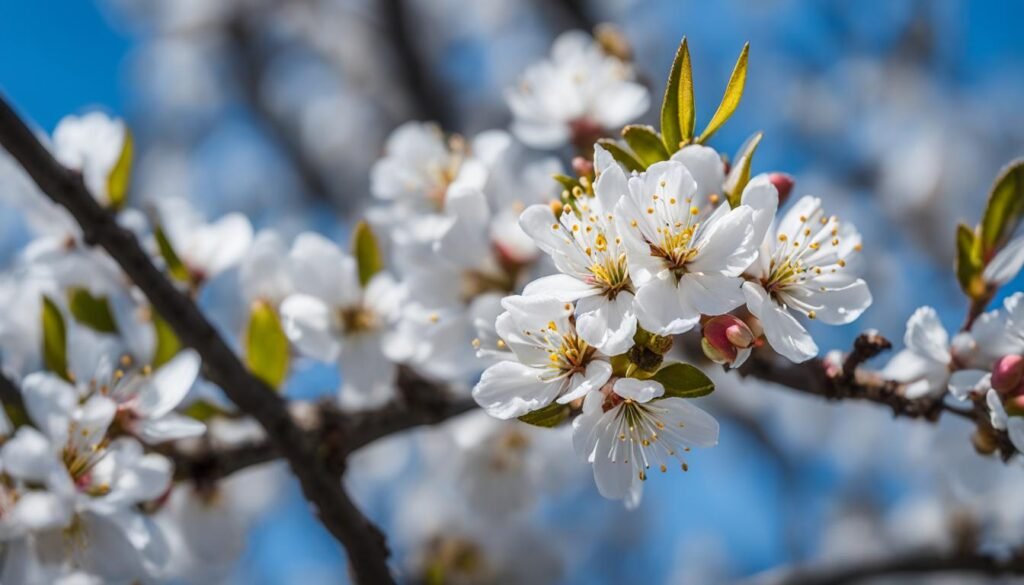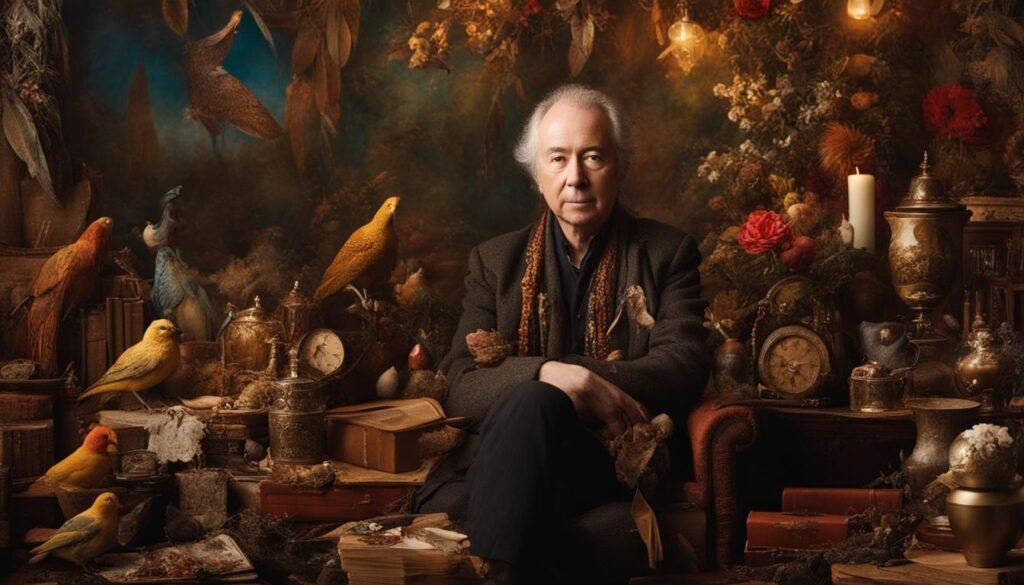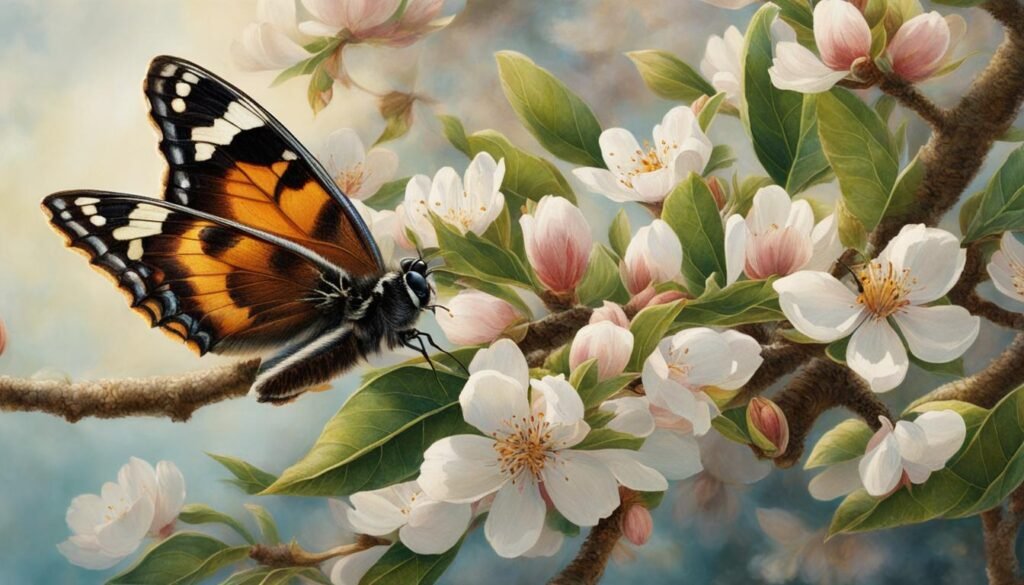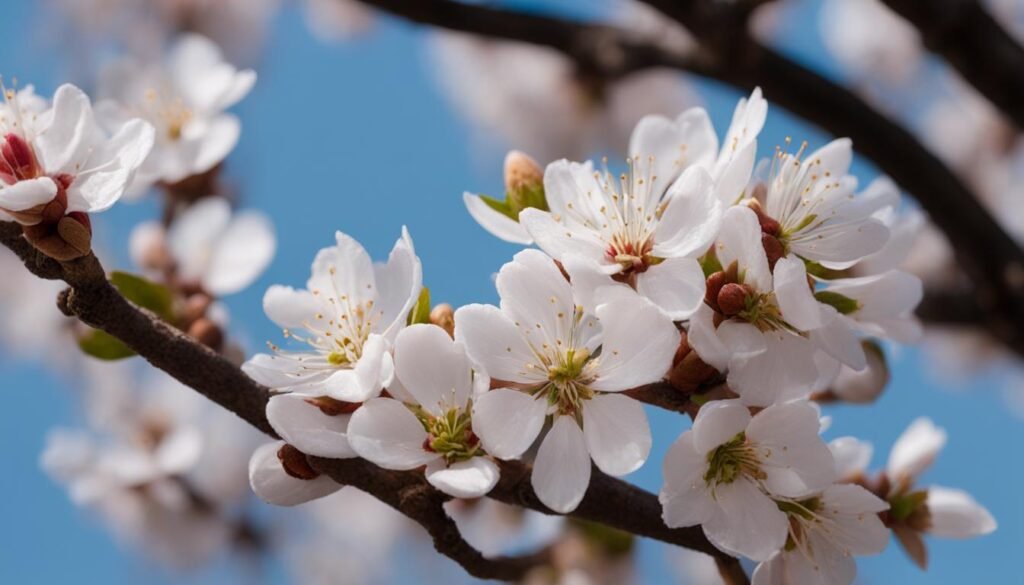Almonds have long held symbolic significance in literature and art, representing a range of themes and emotions. From the delicate white blossoms of Vincent van Gogh’s “Almond Blossom” to the use of almond motifs in storytelling, the almond has captivated the creative imagination. In this article, we will delve into the deeper meanings behind almond symbolism and explore its cultural representation in various artistic mediums.
Key Takeaways:
- Almonds hold symbolic significance in literature and art, representing various themes and emotions.
- Van Gogh’s “Almond Blossom” is a famous example of almond symbolism in art.
- Almond motifs are often used in storytelling to add depth and resonance to the narrative.
- Almond symbolism has cultural significance in different societies and adds layers of meaning to artistic compositions.
- The enduring impact of almond symbolism continues to resonate with audiences, transcending time and artistic boundaries.
The Life of Vincent van Gogh
Vincent van Gogh’s life was a remarkable journey of artistic evolution and emotional expression. Born in the small Dutch village of Zundert in 1853, van Gogh experienced restlessness and inner turmoil throughout his early years. However, it was through his love for literature and his exploration of painting that he truly found his calling as an artist.
Van Gogh’s artistic career was marked by a constant evolution of style and technique. He experimented with various artistic movements, including Impressionism and Post-Impressionism, incorporating bold brushstrokes and vibrant colors into his works. One of his most celebrated paintings is “Almond Blossom,” created in 1890.
“Almond Blossom” holds deep significance in van Gogh’s artistic journey. It represents his unwavering love for his family, particularly his newborn nephew, and serves as a symbol of his own emotional recovery. The delicate white blossoms against the blue sky evoke a sense of hope and renewal, showcasing van Gogh’s ability to capture profound emotions through his art.

Family Symbolism in “Almond Blossom”
“Almond Blossom” is a testament to van Gogh’s belief in the power of familial love and the healing nature of art. The painting’s symbolism extends beyond its aesthetic beauty, as van Gogh used the almond blossom motif to express his deep affection for his brother Theo and his family. The branches, reaching towards the sky, symbolize van Gogh’s hope and optimism for the future, while the white blossoms represent purity and new beginnings. It is a poignant tribute to the strength of familial bonds and the transformative power of love.”
Artist Biography
| Birth | March 30, 1853 in Zundert, Netherlands |
|---|---|
| Artistic Career | 1881-1890 |
| Artistic Movements | Impressionism, Post-Impressionism |
| Notable Works | “Starry Night,” “Sunflowers,” “The Bedroom,” “Irises” |
| Death | July 29, 1890 in Auvers-sur-Oise, France |
Van Gogh’s artistic legacy continues to inspire and captivate audiences around the world. His unique style, emotional depth, and dedication to his craft have solidified his status as one of the most influential artists in history. Through his works, including the iconic “Almond Blossom,” van Gogh’s passion and commitment to artistic expression live on.
The Inspiration Behind “Almond Blossom”
When exploring the origins of Vincent van Gogh’s masterpiece, “Almond Blossom,” it becomes apparent that the painting draws inspiration from both personal experiences and broader cultural influences. During his time in the tranquil town of Arles in the south of France, van Gogh found solace amidst the picturesque landscapes and vibrant flora, which in turn fueled his artistic creativity.
The symbolism of almond blossoms played a significant role in the creation of this renowned artwork. In various societies, almond blossoms have come to represent renewal and hope. For van Gogh, who was going through a transformative period in his own life, the enduring cultural significance of almond blossoms resonated deeply. Through his brushstrokes, he sought to capture the essence of rebirth and the optimistic spirit that these blossoms represent.
As an artist, van Gogh was influenced not only by his surroundings but also by his personal emotions. The creation of “Almond Blossom” came at a time when he was experiencing an emotional recovery and a renewed sense of love for his family. The painting served as a testament to his unwavering affection, symbolizing the hope and strength that blossomed within him.
The Inspiration Behind “Almond Blossom”

“Almond Blossom” is a testament to van Gogh’s mastery of color and his ability to evoke emotion through his artistic expression. The symbolism of the almond blossom, representing renewal and hope, is masterfully captured in the painting’s composition. Van Gogh’s use of vibrant colors and textured brushwork brings the almond blossom to life, inviting viewers to immerse themselves in the beauty and symbolism of the artwork.”
Materials Used in “Almond Blossom”
In the creation of “Almond Blossom,” van Gogh used oil paints on canvas, which allowed him to achieve the rich and expressive tones for which he is renowned. The use of oil paints allowed for a smooth application and blending of colors, contributing to the overall harmony of the painting.
The choice of materials played a crucial role in capturing the symbolism of the almond blossom. The delicate white blossoms symbolizing renewal and hope were contrasted against the vivid blue sky, creating a visual representation of the theme and adding depth to the artwork.
Symbolism in the Painting
The symbolism in “Almond Blossom” goes beyond its visual aesthetics. The painting represents the artist’s personal journey of recovery and hope. Van Gogh painted this piece as a gift for his newborn nephew, symbolizing the joy and optimism that new life brings.
The almond blossom itself carries symbolic significance, representing renewal and the transient nature of life. It serves as a reminder to embrace the beauty and hope that can be found even in challenging times. Through his artistic vision and techniques, van Gogh captured these themes in “Almond Blossom,” creating a timeless masterpiece that continues to resonate with audiences to this day.
Cultural Representation and Artistic Legacy of “Almond Blossom”
The symbolic significance of almonds in literature and art transcends time and cultural boundaries. “Almond Blossom,” the iconic painting by Vincent van Gogh, holds a significant place in the artistic legacy of almond symbolism. The enduring impact of this masterpiece continues to captivate audiences, resonating with individuals on a profound level.
In the realm of cultural representation, almonds have deep historical roots and intertwine with various societies. They hold diverse meanings, symbolizing themes of fertility, rebirth, and prosperity. From ancient Greek funerary rituals to Eastern cultures’ association with beauty and femininity, almonds have left a lasting impression on cultural traditions.
“Almond Blossom” represents hope, renewal, and artistic brilliance, with delicate white blossoms against a vivid blue sky. Its enduring impact continues to inspire artists and evoke a sense of wonder in viewers.”
The artistic legacy of “Almond Blossom” extends beyond van Gogh’s oeuvre. This masterpiece has become a symbol of artistic expression, reflecting the enduring power of almond symbolism in the world of art. Its vibrant colors, expressive brushwork, and profound symbolism have influenced countless artists, leaving an indelible mark on the artistic landscape.
| Symbolic Significance | Cultural Representation | Artistic Legacy |
|---|---|---|
| Hope | Ancient Greek funerary rituals | Inspiration for contemporary artists |
| Renewal | Eastern cultures’ association with beauty | Enduring impact on the art world |
| Artistic Brilliance | Fertility symbolism in various societies | Influence on artistic techniques and expression |
The cultural representation and artistic legacy of “Almond Blossom” underscore the enduring impact of almond symbolism in literature and art. Its themes of hope, renewal, and artistic brilliance continue to resonate with individuals, reinforcing the profound connection between almonds and the human experience.

Symbols that Transcend Time
Almond’s use of almond symbolism in literature showcases the universal and timeless nature of symbols. While Almond’s works are rooted in contemporary themes and settings, the use of almond symbolism connects readers to something timeless and ancient. This symbolic language transcends time and cultural boundaries, resonating with readers across generations and cultures.
By exploring almond symbolism in literature, David Almond has added a new layer of depth to the power of storytelling. His unique exploration of this ancient symbol invites readers on a journey of self-reflection and emotional resonance, creating a profound and lasting impact.
The Symbolism of Almonds in David Almond’s Works
David Almond, a renowned British author, has masterfully incorporated almond symbolism into his works, adding depth and resonance to his storytelling. In his novels, such as “Skellig” and “Kit’s Wilderness,” Almond explores profound themes and emotions through the use of symbolic motifs, including almonds.
Through literary analysis, it becomes evident that almond symbolism in Almond’s works serves as a means of thematic exploration. The almond, a powerful and versatile symbol, is often associated with hope, transformation, and the complexities of human nature. Almond’s use of magical realism further enhances the metaphorical possibilities of almond symbolism, allowing readers to engage with these themes on a deeper level.
One example of almond symbolism in Almond’s works is the character of Skellig, an enigmatic creature who resides in a garage. Skellig’s mysterious existence and transformation throughout the novel symbolize the potential for growth and renewal in challenging circumstances, mirroring the resilience and transformative power of almonds themselves.
Almond symbolism in David Almond’s works adds depth and resonance to his storytelling.
Examples of Almond Symbolism in David Almond’s Works
Let’s explore specific examples of almond symbolism in two of David Almond’s acclaimed novels:
| Novel | Almond Symbolism |
|---|---|
| Skellig | The discovery of a mysterious creature in the garage represents the potential for transformation and growth, much like the budding of an almond blossom. |
| Kit’s Wilderness | Kit’s encounters with the “Death Mother,” a ghostly figure associated with the local mine, symbolize the complexities of mortality and the cycle of life, reminiscent of the almond’s bittersweet taste and ephemeral nature. |
By incorporating almond symbolism into his works, David Almond invites readers to reflect on the universal themes and emotions presented in his stories. Through the exploration of this timeless symbol, Almond creates a narrative landscape filled with depth and meaning, leaving a lasting impression on readers.

Cultural Representation of Almond Symbolism
Almond symbolism is not limited to literature and art; it spans across various cultures, showcasing the universal significance of this timeless symbol. The almond motif has found expression in different artistic mediums, reflecting the diverse perspectives and interpretations of its meaning. From ancient Greek mythology to Eastern cultures’ association with beauty and femininity, almonds have left a lasting impression on cultural traditions.
In ancient Greek culture, almonds were associated with fertility and abundance. The myth of Demeter and Persephone features almonds as a symbol of rebirth and the cyclical nature of life. In the Middle East, almonds have been linked to prosperity and good fortune, often incorporated into wedding rituals and celebrations. The cross-cultural significance of almond symbolism highlights its ability to transcend boundaries and convey profound messages about life, growth, and renewal.
Artistic expression has also embraced almond motifs in different cultures. In Islamic art, almonds are frequently depicted in intricate geometric patterns, symbolic of divine perfection and unity. In Chinese art, almond blossoms symbolize endurance and beauty in the face of adversity. These cultural representations reflect the enduring impact and versatility of almond symbolism, reinforcing its role as a powerful and meaningful symbol.
The Rich Symbolism of Almonds in Different Cultures
Almond symbolism in various cultures can be summarized in the following table:
| Culture | Symbolic Meaning of Almonds |
|---|---|
| Ancient Greece | Fertility, rebirth, cyclical nature of life |
| Middle East | Prosperity, good fortune |
| Islamic Art | Divine perfection, unity |
| China | Endurance, beauty in adversity |
These representations offer a glimpse into the rich symbolism of almonds and how they have been embraced by different cultures throughout history. The almond’s ability to convey profound messages about life, growth, and renewal continues to resonate with individuals on a cross-cultural level, making it a truly universal symbol of significance.

The Historical Significance of Almond Symbolism
The symbolism of almonds has a rich historical importance that can be traced back to ancient civilizations from around the world. Iconographic analysis of almond motifs in art and artifacts reveals their presence in the rituals, religious practices, and visual storytelling of numerous cultures. The exchange of cultural ideas and symbols between civilizations, such as Egypt, the Middle East, and Europe, further contributed to the widespread use and interpretation of almond symbolism throughout history.
In ancient Egypt, almonds were seen as symbols of fertility and rebirth. They were often included in funeral rituals and tombs, as they represented the cycle of life and the promise of new beginnings. The Middle East, with its long history of almond cultivation, also attached great cultural significance to this nut. Almonds were associated with beauty and femininity, and they were often used in traditional practices and celebrations.
During the Renaissance period in Europe, almonds became popular subjects in art, reflecting their continued symbolic importance. In Christian religious art, almonds were frequently depicted as a symbol of the Virgin Mary and the divine nature of motherhood. The almond’s shape, with its outer shell and inner seed, was seen as a representation of the dual nature of Christ, both human and divine.
The historical importance of almond symbolism is evident in its prevalence across cultures and time periods. From ancient civilizations to the Renaissance, almonds have held significant meaning, representing concepts such as fertility, rebirth, and the duality of life and death.
| Historical Period | Symbolic Importance of Almonds |
|---|---|
| Ancient Egypt | Symbol of fertility and rebirth; used in funeral rituals and tombs |
| Middle East | Associated with beauty and femininity; used in traditional practices and celebrations |
| Renaissance | Depicted in Christian religious art as a symbol of the Virgin Mary and the divine nature of motherhood; represented the duality of Christ |
Through iconographic analysis and historical context, we can gain a deeper understanding of the cultural exchanges and interpretations surrounding almond symbolism. The historical significance of almonds in various civilizations highlights their enduring importance and the universal themes they represent. From ancient rituals to religious art, almonds have left an indelible mark on human culture and continue to fascinate with their timeless symbolism.
The Allegorical Significance of Almond Symbolism
Almond symbolism goes beyond its literal representation, inviting us to explore deeper philosophical implications. Through literary analysis, almond symbolism can be interpreted allegorically, uncovering profound insights into the human experience and the complexities of life. This allegorical approach allows us to delve into the symbolism’s broader implications and contemplate universal truths.
In philosophical terms, almond symbolism can represent the journey of self-discovery. Just as an almond tree blossoms and bears fruit, our own personal growth and transformation take time and patience. The almond’s journey from a delicate blossom to a mature fruit mirrors our own journey of self-realization and embracing our true potential.
“The almond’s journey from a delicate blossom to a mature fruit mirrors our own journey of self-realization and embracing our true potential.”
Furthermore, the duality of life and death can be symbolized through almond symbolism. The almond tree’s vibrant blossoms emerge in the spring, signifying new life and hope. However, the almond fruit also contains a kernel that represents mortality and the circle of life. This dual nature of the almond serves as a poignant reminder that life is transient and fleeting, urging us to embrace each moment and find meaning in the impermanence of existence.
Allegorical interpretations in literature
Literary analysis further enhances our understanding of almond symbolism’s allegorical significance. In works of literature, almonds can serve as metaphors for various themes and concepts. For example, the fragility and vulnerability of life may be represented through the delicate white blossoms of an almond tree, highlighting the ephemeral nature of human existence.
Moreover, almond symbolism can explore the interconnectedness of the human experience. Just as almond trees are intertwined, their roots touching beneath the surface, so too are our lives intricately connected with one another. Through literary analysis, we can uncover the profound implications of almond symbolism in storytelling and gain a deeper appreciation for the complexities of the human condition.
Table: Comparing Allegorical Interpretations of Almond Symbolism
| Allegorical Theme | Interpretation | Example |
|---|---|---|
| Journey of Self-Discovery | The almond symbolizes personal growth, resilience, and the pursuit of one’s true potential. | “Like an almond blossom, I blossom with time, revealing the beauty within.” |
| Duality of Life and Death | The almond represents the transient nature of life, the impermanence of existence, and the circle of life. | “In the almond’s fruit, I find solace in the acceptance of life’s ephemerality.” |
| The Interconnectedness of the Human Experience | The almond symbolizes the intricate connections between individuals, highlighting the shared human condition. | “In the intertwining roots of almond trees, I find solace in our interconnectedness.” |

Examples of Almond Symbolism in Poetry:
“Like an almond tree laden with blossoms,
your beauty shines bright, even in darkness.”
– Poet Unknown
This quote exemplifies the metaphorical use of almond symbolism to express the enduring beauty and resilience of the human spirit. The almond tree’s blossoms symbolize the inherent beauty within each individual, even in the midst of challenging circumstances.
In conclusion, almond symbolism in poetry offers a versatile and evocative tool for poets to explore a range of emotions and experiences. Whether representing vulnerability or strength, the almond serves as a powerful metaphor that resonates with readers, inviting them to reflect on the complexities of the human condition. Through poetic analysis, we can appreciate the enduring significance of almond symbolism in the world of literature and art.
Almond Symbolism in Painting
Artistic analysis of almond symbolism in painting allows us to delve into the depths of visual metaphors and iconic representations. The almond, with its delicate blossoms and contrasting hues, has been a recurring motif in art throughout history, capturing the essence of diverse emotions and concepts.
Through the use of vibrant colors and expressive brushwork, artists have conveyed the symbolic significance of almonds in their paintings. The visual metaphors embedded within these artworks evoke themes of love, hope, and the transient nature of life. From Renaissance masterpieces to contemporary works, almond symbolism continues to captivate viewers, resonating on a profound and universal level.
“The almond blossom stood as a symbol of the awakening of love and the regeneration of life. Through his brushstrokes, van Gogh expressed the transformative power of this delicate flower,” says art critic Emma Davis.
One iconic representation of almond symbolism in painting can be seen in Vincent van Gogh’s “Almond Blossom.” This masterpiece, created during a period of personal and artistic renewal, showcases the artist’s emotional connection to the almond tree and its blossoms. The interplay of bold colors and textured brushstrokes immerses the viewer in the vibrant energy and symbolic depth of the painting.
Comparative Analysis of Almond Symbolism in Painting
| Artist | Painting | Symbolic Interpretation |
|---|---|---|
| Leonardo da Vinci | Mona Lisa | The subtle presence of an almond-shaped shadow behind the figure represents the enigmatic nature of the painting and the hidden depths of the human soul. |
| Édouard Manet | A Bar at the Folies-Bergère | The inclusion of a bowl of almonds in the composition provides a metaphorical contrast to the facade of illusion and indulgence depicted in the painting, hinting at a deeper truth beneath the surface. |
| Frida Kahlo | The Two Fridas | The use of an almond-shaped heart in the painting symbolizes the duality of Frida Kahlo’s identity and the emotional turmoil she experienced during her life. |
These examples showcase the diverse ways in which artists have employed almond symbolism to convey their artistic vision and explore profound themes. The use of visual metaphors and iconic representations allows for a rich and layered interpretation of almond symbolism in painting, inviting viewers to contemplate the complexities of the human experience.

Almond symbolism in painting continues to inspire and provoke thought, offering a visual journey into the depths of human emotions and the enduring power of this ancient symbol. From the delicate white blossoms to the intricate details of the almond nut, artists have harnessed the versatile nature of almonds to create meaningful and evocative works of art.
Conclusion
Throughout literature and art, almond symbolism has played a significant role, captivating audiences with its profound meanings. The almond has represented themes of hope, rebirth, and the intricacies of the human experience, resonating across cultures and artistic mediums. From Vincent van Gogh’s iconic “Almond Blossom” to David Almond’s evocative storytelling, almonds have left an enduring impact on the creative landscape.
The cultural representation of almond symbolism further enhances its significance, as different societies have imbued almonds with diverse meanings such as fertility, beauty, and prosperity. Across history, almond motifs have found their place in ancient civilizations’ rituals, religious practices, and artistic expressions, showcasing the symbol’s rich historical importance.
Almond symbolism also extends beyond its literal interpretation, inviting allegorical and metaphorical explorations. Through philosophical analysis and poetic interpretations, almonds have come to symbolize broader concepts like self-discovery, the cycle of life and death, and the interconnectedness of humanity.
As we reflect on the enduring impact of almond symbolism, we recognize its ability to transcend time and artistic boundaries. Almonds continue to inspire and captivate, reminding us of the profound depth and beauty that can be found in literature, art, and the shared human experience.
FAQ
What do almonds symbolize in literature and art?
Almonds have long held symbolic significance, representing themes of hope, renewal, and the complexities of the human experience.
What is the significance of almonds in Vincent van Gogh’s life and artwork?
Almonds, particularly depicted in “Almond Blossom,” symbolize van Gogh’s unwavering love for his family and his own emotional recovery.
Why did Vincent van Gogh choose almond blossoms as a symbol in his artwork?
The symbolism of almond blossoms, representing renewal and hope, resonated with van Gogh during a transformative period of his life.
What artistic techniques did Vincent van Gogh use in creating “Almond Blossom”?
Van Gogh employed bold and vibrant colors, impasto brushwork, and oil paints on canvas to capture the rich symbolism of renewal and hope in his painting.
How has almond symbolism left an enduring impact in cultural representation?
Almond symbolism, as seen in van Gogh’s artwork and in the literary works of David Almond, continues to captivate audiences and resonate on a profound level.
How does David Almond use almond symbolism in his literature?
David Almond utilizes almond motifs to add depth and resonance to his storytelling, exploring themes of hope, transformation, and the complexities of human nature.
What cultural representations are associated with almond symbolism?
Almonds hold diverse meanings in different societies, often associated with themes of fertility, rebirth, and prosperity.
What is the historical significance of almond symbolism?
Almond motifs have been present in the rituals, religious practices, and visual storytelling of numerous ancient civilizations, reflecting cultural exchanges and interpretations throughout history.
How can almond symbolism be allegorically interpreted?
Allegorically, almond symbolism can represent broader concepts such as the journey of self-discovery, the duality of life and death, or the interconnectedness of the human experience.
How is almond symbolism explored in poetry?
Almond symbolism in poetry can be interpreted in various ways, representing fragility and vulnerability, resilience, and beauty in the face of adversity.
How does almond symbolism manifest in painting?
Almond symbolism in painting offers visual metaphors and symbolic interpretations that explore the intricacies of human emotions and the enduring power of this ancient symbol.




